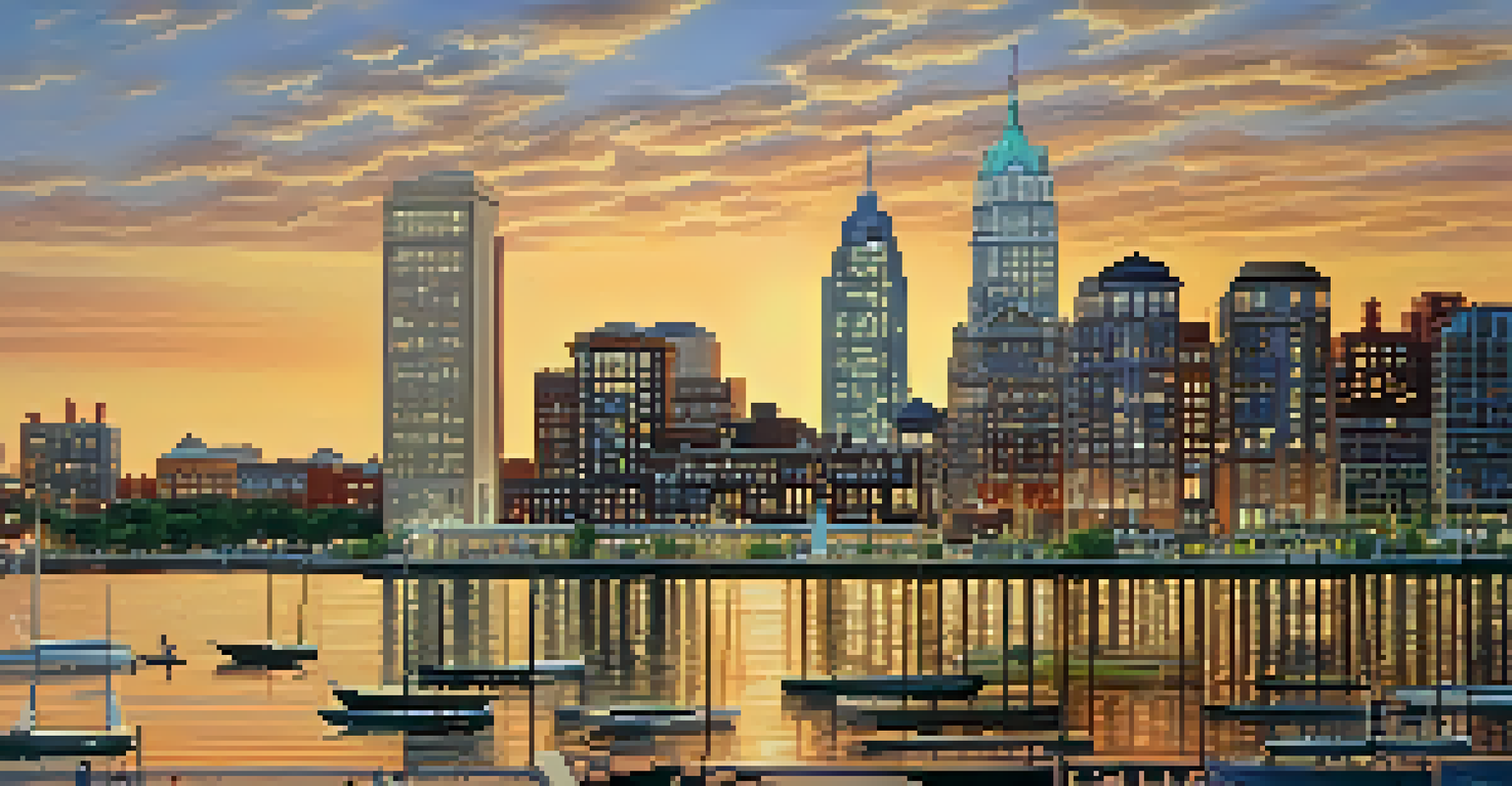The Evolution of Jersey City's Landmarks Over the Decades

The Early Days: Jersey City's Historic Beginnings
In the early 19th century, Jersey City emerged as a bustling hub, primarily due to its strategic location along the Hudson River. The waterfront was dotted with piers, and landmarks like the Colgate Clock became iconic symbols of the area’s industrial growth. This period set the stage for the rich architectural tapestry that would define the city for generations.
The past is never dead. It's not even past.
As factories and warehouses sprang up, the skyline began to take shape, influenced by various architectural styles. The Gothic Revival style found its way into structures like the Jersey City City Hall, showcasing the city's aspirations and growth. These early landmarks not only served practical purposes but also reflected the community's identity and pride.
With each passing decade, Jersey City's landmarks evolved alongside its population, which was a melting pot of cultures. This blend of influences can still be seen today, as many of the original buildings hint at the city's diverse heritage. Understanding this early evolution helps us appreciate the depth of Jersey City's historical significance.
The Roaring Twenties: A Time of Prosperity and Change
The 1920s brought prosperity to Jersey City, marked by the construction of new skyscrapers and public buildings. This era saw the rise of Art Deco architecture, with landmarks like the Jersey City Medical Center showcasing ornate designs and modern amenities. These structures symbolized optimism and the promise of a bright future for residents.

During this decade, the city also embraced cultural institutions, with theaters and museums popping up throughout the area. The opening of the Jersey City Museum in 1929 marked a commitment to preserving local history and the arts. This focus on culture added another layer to the city's evolving landscape, making it a vibrant place to live and visit.
Jersey City's Architectural Evolution
The city’s architectural landscape has transformed over the decades, reflecting its historical significance and diverse cultural influences.
However, the Great Depression soon loomed, challenging the growth experienced during the 1920s. Many of the newly built structures faced neglect, leading to a complex relationship between the city and its landmarks. Understanding this juxtaposition highlights the resilience of Jersey City as it navigated periods of both prosperity and hardship.
Mid-Century Modernism: Revitalization and Urban Planning
The post-World War II era brought new challenges and opportunities for Jersey City. Urban planning initiatives aimed to revitalize the area, leading to the construction of modernist buildings that contrasted sharply with older architecture. This shift reflected broader trends in American architecture and society, as cities adapted to changing needs.
To be rooted is perhaps the most important and least recognized need of the human soul.
Landmarks like the Newport Centre Mall emerged during this time, representing a shift towards consumerism and suburban ideals. The mall became a social hub, showcasing how the city was evolving to meet the demands of its residents. This focus on commerce illustrated a changing landscape where landmarks served both cultural and economic purposes.
However, with urban renewal came controversy, as some historic buildings were lost in the name of progress. This period taught Jersey City valuable lessons about balancing modernization with preservation, shaping the ongoing conversation about the value of its landmarks. The legacy of mid-century modernism continues to influence the city’s architectural choices.
The 1980s: A Period of Decline and Resilience
The 1980s marked a challenging time for Jersey City, characterized by economic decline and urban decay. Many neighborhoods faced neglect, and several historic landmarks fell into disrepair. Yet, this era also sparked grassroots movements focused on preservation and community revitalization.
Local advocacy groups emerged, working tirelessly to save significant sites like the Central Railroad of New Jersey Terminal. Their efforts highlighted the importance of maintaining Jersey City’s heritage amidst the changing urban landscape. This period fostered a sense of community pride and resilience that would play a crucial role in the city’s future.
Resilience Amid Economic Challenges
Despite facing economic decline and urban decay, grassroots movements in the 1980s sparked community pride and revitalization efforts.
As the decade progressed, revitalization efforts began to take shape, paving the way for a renewed interest in the city’s history and architecture. Restoration projects not only fixed crumbling landmarks but also redefined the identity of Jersey City. This resilience set the stage for the transformative years that lay ahead.
The Turn of the Century: A New Era of Development
The late 1990s and early 2000s ushered in a renaissance for Jersey City, with a surge of development transforming its skyline. New luxury condos and high-rises emerged, alongside efforts to preserve historic sites. This balance between old and new is a defining characteristic of the city today.
Landmarks like the Liberty Science Center and the revitalized waterfront area became symbols of this new era, attracting both residents and visitors. The waterfront, once a hub of industry, transformed into a vibrant recreational space, showcasing the city’s evolution towards a more community-focused environment. This shift reflects broader trends in urban development, emphasizing accessibility and quality of life.
Moreover, the influx of new residents brought diverse perspectives and cultural experiences, enriching the city’s identity. This period of growth redefined Jersey City, illustrating how landmarks can evolve while honoring their roots. The city’s future now rests on the foundation of its storied past, making it a fascinating place to explore.
Cultural Renaissance: Celebrating Diversity in Landmarks
As Jersey City moved into the 2010s, it experienced a cultural renaissance that celebrated its rich diversity. The city became a canvas for artists, with murals and public art installations adorning many buildings. These creative expressions complemented existing landmarks, adding vibrancy to the urban landscape.
Festivals and community events began to flourish, showcasing the multicultural fabric of the city. Landmarks like the Historic Downtown district became focal points for these celebrations, drawing people together to honor their heritage and shared experiences. This sense of community engagement highlights how landmarks serve as more than just physical structures—they are living parts of Jersey City’s identity.
Balancing Preservation and Growth
As Jersey City looks to the future, there is a critical focus on preserving historic landmarks while accommodating modern development needs.
Additionally, the city’s commitment to preserving its history became evident through initiatives aimed at restoring and highlighting significant sites. This focus on cultural heritage ensures that future generations will appreciate the stories behind Jersey City’s landmarks. As the city continues to grow, it remains rooted in the values that shaped it.
Looking Forward: The Future of Jersey City's Landmarks
As we look to the future, Jersey City’s landmarks stand at a crossroads of preservation and innovation. The challenge lies in maintaining the integrity of historic sites while accommodating modern needs. This delicate balance is crucial for sustaining the city’s unique character amid rapid change.
Developers and city planners are increasingly recognizing the importance of integrating historical elements into new projects. Initiatives aimed at revitalizing existing structures rather than tearing them down reflect a growing awareness of the value of heritage. This trend not only preserves the past but also enhances the overall aesthetic of the city.

Ultimately, the future of Jersey City's landmarks will depend on the continued involvement of the community. Engaged residents can advocate for thoughtful development that respects the city’s history while fostering growth. By honoring its past, Jersey City can confidently stride into the future, ensuring that its landmarks tell the ongoing story of this vibrant city.